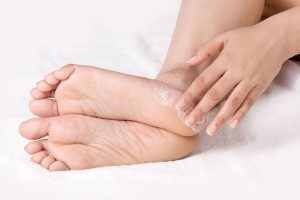 As a podiatrist, I see a ton of foot problems. One of the most common questions from patients I get is about itchy dry skin on feet. I noticed that patients are coming in for foot pain, fractures, heel pain, flat foot, Achilles tendonitis, etc, but many of them have untreated itchy dry skin on feet and eczema issues that can be easily treated by some OTC (Over-the-counter) inexpensive topical medications.
As a podiatrist, I see a ton of foot problems. One of the most common questions from patients I get is about itchy dry skin on feet. I noticed that patients are coming in for foot pain, fractures, heel pain, flat foot, Achilles tendonitis, etc, but many of them have untreated itchy dry skin on feet and eczema issues that can be easily treated by some OTC (Over-the-counter) inexpensive topical medications.
However, have you ever shopped at a local pharmacy or retail store such as Walgreens, CVS, Walmart, Target, etc. and searched through the lengthy shelves of medications and tried to find a safe and effective lotion or cream that actually works? These stores can really make you dizzy! So I have tried to make it easier by doing my professional research and giving you my top ten list of safe and effective topical over-the-counter medications.
First I have to educate you on the different types of topical bases that are available because they will effect the potency of the medication. The difference between an ointment, lotion, cream, gel, foam, and solution. Most of the main OTC medications will be either ointments, creams, or lotions.
- Ointments are the strongest base and will make any type of topical medication stronger. An ointment is 20% water and 80% oil.
- Creams are second strongest behind ointments and are 50% water and 50 % oil.
- Lotions are 3rd strongest in potency of topical medications.
- gels are last in potency since most of a gel is made of alcohol and water.
- Occluded areas (applying the topical medication then covering with a object to help drive the medication into the skin) will also increase the potency of the medication. See the Pedinol Sleep and Heel Rejuventing kit below.
What is in medications for itchy dry skin on feet?
Dry skin is caused by a loss of water in the upper layer of the skin. Emollients are substances that soften and moisturize the skin and decrease itching and flaking. Emollients/moisturizers work by forming an oily layer on the top of the skin that traps water in the skin. Petrolatum, lanolin, mineral oil, and dimethicone are common emollients.
Lactic acid, salicylic acid, and urea are keratolytics. They increase moisture in the skin by softening/dissolving the horny substance (keratin) holding the top layer of skin cells together. This helps the dead skin cells fall off and helps the skin keep more water in. Higher strengths of urea are used to treat corns, callous, and some nail problems (e.g., ingrown nails). Urea is also used to help remove dead tissue in some wounds to help wound healing.
What should you be concerned about with topical medications?
Parabens and fragrances
Parabens and fragrance are both problems and in almost 85% of all topical medications. In the 1990s, parabens were deemed xenoestrogens―agents that mimic estrogen in the body. “Estrogen disruption” has been linked to breast cancer and reproductive issues. And in 2004 British cancer researcher Philippa Darbre, Ph.D., found parabens present in malignant breast tumors. As a result, experts in many countries are recommending limits on paraben levels in cosmetic products. What’s more, watchdog organizations worry that if parabens can be stored in the body, over time they could have a cumulative effect and pose a health risk. See this blog for more informations on parabens.
There are over 500 potential chemicals that can be used under the single name “fragrance” found on the label of many products, not just perfumes and colognes. Fragrances are found in “air fresheners,” room deodorizers, cosmetics, fabric softeners, laundry detergents, candles, skin softeners, lotions and many other places. Manufacturers are not required to list ingredients on the labels of these products, nor do they have to reveal the specific ingredients that qualify as “fragrance” to regulating authorities because they are protected as trade secrets.
Some of the most common chemicals in perfumes are ethanol, acetaldehyde, benzaldehyde, benzyl acetate, a-pinene, acetone, benzyl alcohol, ethyl acetate, linalool, a-terpinene, methylene chloride, styrene oxide, dimenthyl sulphate, a-terpineol, camphor, and limonene. Some of these chemicals cause irritability, mental vagueness, muscle pain, asthma, bloating, joint aches, sinus pain, fatigue, sore throat, eye irritation, gastrointestinal problems, laryngitis, headaches, dizziness, swollen lymph nodes, spikes in blood pressure, coughing, and burning or itching skin irritations.
My top ten list:
Here’s my suggested top 10 list with retail prices and size of bottles and what country there made in (note that medications may go on sale and also there may be different sizes available):
10. Aveda Foot Relief, 4.2 oz, $21, Minnesota, MN
A little more expensive, but they use more than 50% of there ingredients are from natural sources.
9. Aveeno Skin Relief Healing Ointment, 3 oz, $9.99, Johnson & Johnson Company, USA
No fragrance or parabens. They only use natural ingredients for all there topical medications.
8. Cetaphil 3.0 oz, $6.89, Canada
7. Poofy Organics Preventative Stretch Mark Butter, 8 oz, $22.00, New York, NY, USA
Great for Postpartum birth for stretchmarks also!
6. Eucerin, 6.8 oz, $7.99, Poland
5. Amlactin, 7.9 oz, $16.99,
4. Lactinol HX, 4.0 oz, $19.89, Canada
*3. Pedinol Ureacin 20, 4.0 oz, $15.99, Canada
I suggest the Sleep and Heel kit. This kit has the cream as part of the deal. This kit is perfect for extremely dry and crack heels and can be worn at night to get the best treatment.
2. CeraVe Renewing SA lotion, $16.50, Canada
Its patented Multivesicular Emulsion (MVE®) for controlled release over time with ceramides that moisturize and soften skin. CeraVe® SA also uses salicylic acid to help slough off dry, rough bumpy skin. It’s enriched with antioxidant vitamin D.
*1. Kera-42 Cream, 6.0 oz, $18.00, Atlanta, GA, USA
*Only can be purchased at a medical office. Available at our office for in office only purchase.

Dr. Dennis M. Timko
Podiatrist
Dr. Dennis Timko, is a podiatrist in the St. Louis, Eureka, MO. area. Dr. Timko specializes in diabetic foot care, foot surgery, AFOs, and orthotics. Dr. Timko is the solo owner of Arch City Foot & Ankle, which has been in business since 2003.
